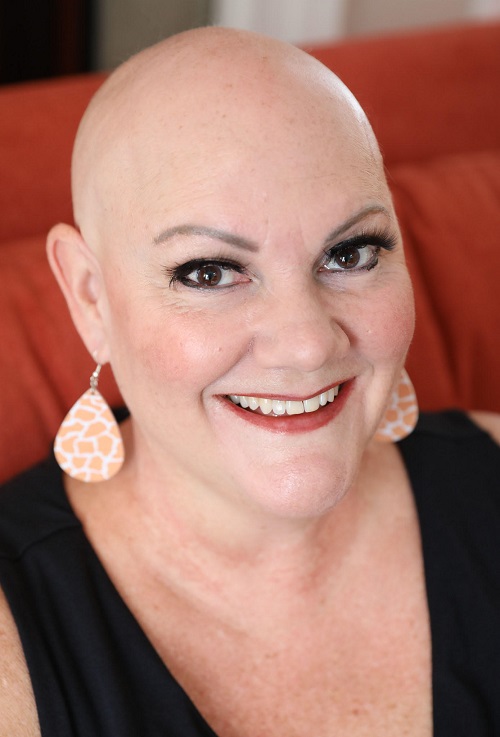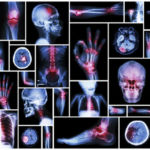For our Chronic Pain Partners newsletter, journalist Karina Sturm spoke with Christie Cox, fellow zebra and author of the new EDS book “Holding It All Together When You’re Hypermobile.” Cox shares her journey to getting diagnosed with EDS, what motivated her to write this book, and what the book is all about.
[We will review this fabulous new EDS book for a future newsletter edition.]
Karina Sturm:
Hi Christie! I am so glad we could meet, and I am super excited to hear more about your new EDS book! Thanks so much for creating another resource for people with EDS. Would you like to share what motivated you to write it and give me a summary of the book’s content?
Christie Cox:
The book was just released and is called “Holding It All Together When You’re Hypermobile.” It really started with me being an EDS and POTS patient because all of us continuously research so much information in order to help ourselves and improve our medical conditions. I thought, “You have gathered all this great information, but now what?” I wanted to try not only to collect it but also to put it in a shareable form. So I spent a year and a half putting together all the techniques/treatments that helped me get better and also everything I tried that didn’t work for me. The book is a tale of all the challenges to finding a diagnosis and tools to be able to live your best life when you’re dealing with a chronic invisible illness that not very many people or doctors understand.
Sturm:
You spent almost two years putting this book together? Wow!
Cox:
Yes.
Sturm:
That’s pretty amazing.
Cox:
It was inspired by one of my doctors who said, “You’re doing really well! You need to write this up!” And I said, “I can’t write a book.” But he insisted I could. Additionally, I had the wonderful opportunity – a joint effort, pun intended – of having several EDS experts, doctors, advocates and community members participate and allow me to interview them in the book. It’s been a great community effort.
Sturm:
That’s so cool! Can you tell me a little more about your journey? How long did it take until you got diagnosed with EDS and all the comorbid conditions?
Cox:
Like for many of us, my journey was a long one. For me, it was the birth of my child that triggered many EDS symptoms. I went from being able to manage life to being unable to manage life. It took me hundreds of doctor appointments trying to get the correct diagnosis. And I got misdiagnosed, like many of us, with every other thing, but nothing ever seemed like the root cause. It was always just a symptom. I even had the opportunity to go to the National Institutes of Health (NIH). They couldn’t figure it out.
What finally pointed me in the right direction was a car accident. I was passing out while driving – back then, I just thought I was falling asleep – and I had a car accident and hit the person in front of me that was stopped. This led me to a regular physical therapist for what I thought was whiplash. I went in there, laid down, and they reached underneath my head and neck to feel around. He said, “Well, we have a problem. I think you need to go to the emergency room.” He wrote down on a piece of paper words that were foreign to me, which was atlantoaxial instability and craniocervical instability. I went to the ER, handed them the note, and they ran some X-rays, sent me home, and told me to drink a glass of wine and get over it. I hate that these things happen to all of us, but ultimately, this dismissal made me want to figure this out. I went to see an informed geneticist who diagnosed me with hypermobile EDS. They, in turn, sent me to a cardiologist who diagnosed me with POTS and Chiari. So it was like the domino effect.
I got a lot of relief from cervical spine fusion to correct the craniocervical instability I had in March of 2021. When I woke up the following day, it was like a new beginning. I had degraded so severely beforehand that I couldn’t walk, I couldn’t talk. Then I got this new beginning, and I felt like I needed to use this chance to help other people because it really shouldn’t take 17 years to figure this out. It shouldn’t be this hard. There need to be more information, more resources, and more providers who understand EDS.
Sturm:
That is so true. I’m really sorry they dismissed you with such a serious diagnosis and sent you home. It’s a classic, though. Happens to all of us.
Cox:
Yeah, it is horrible, and it is typical. And at the time, you don’t know any better.
Sturm:
Yeah, unfortunately, that happened to me, too, a couple of times in different contexts. Can you talk a little about some of the challenges people with an incurable, invisible illness face?
Cox:
Some of the initial challenges are mostly being dismissed by doctors, being disbelieved by family members and loved ones who think that this is all in your head or you’re making it up for attention. When you reach the point of getting a diagnosis, which is overwhelming in a good way, it also gives you the opportunity to start doing research and connecting with others. And that’s the second phase challenge. Some of the challenges that I face and which I share in my book is how to come to terms with having a chronic illness and the losses it means. For example, I lost my career; we lost our home, and we had to move so that we could live on just one salary. It’s turning all of that loss into something positive for yourself and for other people.
Sturm:
So how did you find acceptance for yourself and come to terms with your illness?
Cox:
It’s a long, arduous process. Having supportive people around you is critical. I’m fortunate that I have a fantastic husband. My family of origin was not so supportive, and that was pretty devastating to me. I had to emotionally work through that. I spent a lot of time in nature. I spent a lot of time learning how to be mindful, learning how to use breathing techniques to calm my vagus nerve and calm my autonomic nervous system so that I could heal my body from the inside out. And the most important thing, which is also the hardest, is being patient—being a patient patient while waiting on a waiting list to see the right doctor or for that test to come back.
Sturm:
Can you share your top three coping strategies?
Cox:
Something fundamental, which I hear echoed in the community, is movement, especially when you’re facing chronic pain. When I don’t want to do any form of exercise, it is usually the time when I should because moving through the pain is helpful. So I do easy things like walking two or three times a day. I ride a recumbent bike. Maybe it’s for five minutes; maybe it’s only two minutes.
Number two is managing your mind, your expectations of yourself and the people around you, and what they can and can’t do for you is critical. It’s essential to have a positive attitude. I don’t suggest that having the right mindset will help get your subluxed rib back in place, but it will help you cope with the fact that you’re going through this. Number three is being organized. You must be a patient who, when you go, and you have the opportunity to be in front of these smart medical professionals, is able to succinctly state what their goal is and why they are there. And to get the most out of the time with medical professionals, you need to keep and organize your records. It’s a full-time job to have this diagnosis. And the more organized you are, the better outcome you’ll get from the medical community.
And then my favorite tip comes from one of my inspirations for this book, whose a family member with EDS, POTS and mast cell activation: Just eat when you’re hungry and sleep when you’re tired. Everything else will work itself out.
Sturm:
I like that one. Even though it wouldn’t work out for me because then I would sleep a lot more than I already am. [Laughs].
Cox:
Well, sometimes you have to pay attention to your self-care. And remember, it’s not selfish, and you’re not going to be able to do all the things that you do for other people or the people in your family or your community if you’re not taking care of yourself.
Sturm:
And are you following that advice as well?
Cox:
I’m trying. Sometimes I do. The past two weeks, not so much. [Laughs].
Sturm:
Thanks for being honest. I keep telling people they have to take it a little slower. I offer to take things off their plate. And then I’m the one who’s like, “Who needs sleep?” What I am saying is: I always give good advice but don’t follow it myself.
Cox:
It is the hardest advice. I’ve had a really positive, overwhelming response to the book from the community, so I told myself to take my own advice and slow down, stop and breathe, go for a walk because if I don’t take care of my wellness, then I’m going to have to take care of my illness.
Sturm:
Tell me a little bit about the response from the community. I saw your book was number one in several categories on Amazon. How did that feel?
Cox:
It was more than I could have ever dreamed. My goal was to put the book out for the EDS Society’s conference in Arizona. I worked diligently to get that done. On the day of the conference, I was putting it out there for free. And my world blew up. Within 48 hours, there were over 800 people that had downloaded it, which rocketed it up to the number one new release, and it even made the bestseller list. But the really magical part was the doctors, physical therapists, and the other patients who were at the conference and since then have sent me messages to say, “I read this book, and now I can share it with my mom, who doesn’t get it,” or the doctors who say, “You’ve done an excellent job. Will you help me ghostwrite a book?”
Sturm:
So what’s next for you? Another book?
Cox:
I am not a hundred percent sure. I’m a big supporter of the team at the Norris Lab at MUSC, and a portion of the book proceeds will fund their research and try to identify the hEDS genes. They ultimately want to develop an EDS Institute where people with EDS can come and see all the different kinds of specialists, advocates and counselors they need.
Sturm:
That sounds like a dream, honestly, isn’t it?
Cox:
I’m trying to figure out how I can participate in that process, knowing it’s going to take decades and funding. Dr. Norris and Dr. Gensemer are incredible, and it’s just such a fantastic thing to observe and be a tiny little part of their work.
Sturm:
I’m sure it is. They are empowering the community, and so are you! What do you feel are ways to empower ourselves and our support systems?
Cox:
I believe in the power of this community and what I call crowdsourcing our care. So share what you’ve learned, share your knowledge, and share the gift of understanding. The number of people that have contacted me and said, “I read your book, and I’ve given it to my loved one, my partner, my boss, and now they get it!” That would be something you can do to empower yourself.
Sturm:
Knowledge is, indeed, the most empowering tool we have. To end this interview, can you tell us where we can buy your book?
Cox:
It’s available on Amazon in all countries. It’s also on Goodreads and sites like Barnes and Noble and all major retailers. I am currently working on an audio version, which will be coming out in a few weeks. You can get more information about the book on my website at https://www.holdingitalltogether.com/. I would be so grateful for all of you to pay it forward. If you read and learn something, pass it on, share it, write a review, whatever you can to help us help each other.
Sarah Cook, Jackie Saa & Karina Sturm
October 2022




Wonderful. Thank you for sharing this